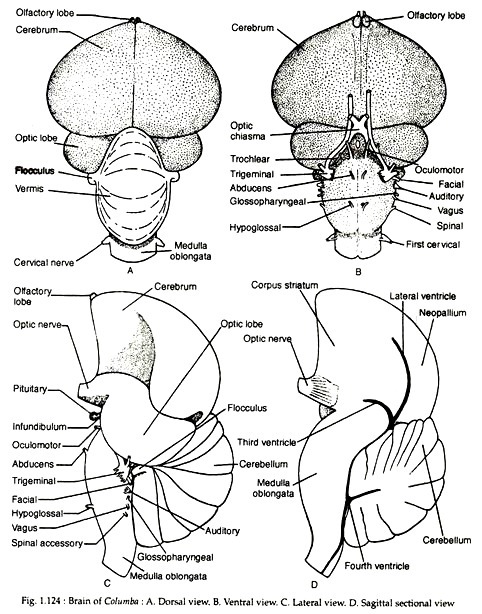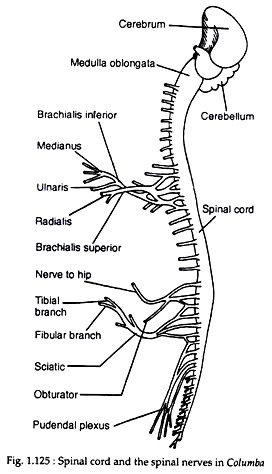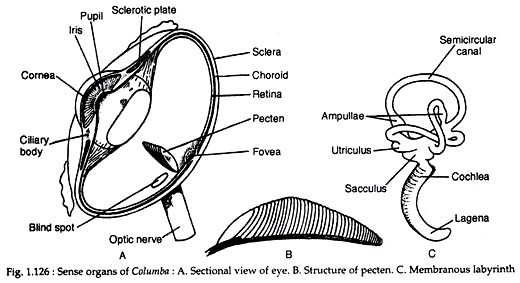The nervous system of pigeon is divisible into:
(1) Central Nervous System,
(2) Peripheral Nervous System, and
(3) Autonomous Nervous System.
ADVERTISEMENTS:
(1) Central Nervous System:
The Central Nervous System includes the brain and the spinal cord:
(i) Brain:
The brain of pigeon is peculiar for its short and rounded form. It is built upon the same structural plan as that of other vertebrates.
ADVERTISEMENTS:
Coverings:
The brain is covered by two meninges, an inner piamater and an outer duramater.
Parts of the brain:
The olfactory lobes are poorly developed and form the most anterior part of the brain (Fig. 1.124A). The cerebral hemispheres are large, situated just posterior and dorsal to the olfactory lobes. The cerebral hemispheres consist largely of corpora striata (Fig. 1.124D). The corpora striata are composed of solid mass of tissue and control the reflex behaviours of the animal.
ADVERTISEMENTS:
Each corpus striatum is differentiated into three regions—the upper portion is called the hyper-striatum, the lateral region as the mesostriatum and the lower part as the paleostriatum. The roof of each cerebral hemisphere is called the neopallium. The neopallium is un-convoluted. The cerebral hemisphere becomes expanded posteriorly to meet the cerebellum.
The diencephalon is inconspicuous and remains completely covered by the cerebral hemispheres and cerebellum. From the hypothalamus, a hypophysis arises. On the roof of the diencephalon, a small pineal body projects between the cerebral hemispheres and cerebellum.
The optic lobes are large in size and spherical in shape. They are pushed to the lateral side due to the backward growth of the cerebral hemispheres. The optic nerves are prominent and form optic chiasma (Fig. 1.124B) situated ventral to the midbrain. A major portion of the optic nerves passes into the thalamus and the rest to the midbrain. The midbrain as well as the thalami has reciprocal connections with the corpus striata of the cerebral hemispheres.
The cerebellum is highly developed and consists of a large central vermis and two small lateral lobes — the flocculi (Fig. 1.124B and C). Transverse grooves are present on the surface of the vermis. The over-development of cerebellum is possibly connected with the control of movement and the precise timing during flight.
Like that of other vertebrates, pigeon possesses both spino-cerebellar and vestibulo-cerebellar nerve tracts. In addition to these two tracts, tecto-cerebellar and strio-cerebellar tracts are present. The cerebellum is solid, because the fourth ventricle does not extend into it. The medulla oblongata has a prominent ventral fissure.
Ventricles:
The lateral ventricles are greatly reduced and represented by small crescent-shaped cavities located at the posterior end of cerebral hemispheres. The third ventricle (Fig. 1.124D) is a small slit-like cavity situated posterior to the corpus striatum. The lateral ventricles and the third ventricle are communicated by foramen of Monro.
Each optic lobe contains an extension from the aqueduct of Sylvius, a narrow passage contained in the midbrain connecting the third ventricle with the fourth ventricle. The fourth ventricle is a small cavity between the cerebellum and medulla oblongata.
ADVERTISEMENTS:
(ii) Spinal cord:
The spinal cord is covered by Pia mater and Dura mater like that of brain. Along its length, the spinal cord is enlarged in the cervical and lumbosacral regions. Each such enlargement gives origin to a pair of plexi which, in turn, send nerves to the limbs. In the region of the lumbosacral enlargement, the spinal cord is open and the cavity becomes expanded to form a diamond- shaped sinus rhomboidalis. This cavity is filled with a fatty substance.
(2) Peripheral Nervous System:
The cranial and spinal nerves constitute the peripheral nervous system. This system is essentially same as in Calotes. Twelve pairs of cranial nerves emerge out of the brain. The trigeminal originates by many roots from the lateral part of medulla oblongata ventral to the optic lobes.
It has three branches:
(i) Ophthalmic,
(ii) Maxillary and
(iii) Mandibular.
The trigeminal nerve passes through the orbital fissure and innervates the skin, and muscles of tongue and larynx. The facial nerve — after arising from the lateral surface of medulla but posterior to trigeminal — sends nerve to the pharynx and muscles for mastication.
The glossopharyngeal originates superficially from the lateral surface of the medulla posterior to the auditory nerve and comes out of the cranium through a small foramen between ear and hypoglossal foramen. It sends branches to palate, pharynx, larynx and taste-buds on the tongue.
The vagus nerve originates from the lateral side of the medulla, posterior to glossopharyngeal. The main nerve trunk is found in the neck sheathed in the connective tissue. It runs posteriorly along the neck region adjacent to jugular vein. Near the brachial plexus it sends branches to the oesophagus and crop. The main trunk sends branches to heart, lungs and abdominal viscera.
The spinal accessory (XI) is a motor nerve. It arises from the lateral surface of medulla oblongata posterior to vagus. It supplies nerves to the neck muscles. The hypoglossal (XII) nerve arises from the ventral surface of the medulla posterior to abducens nerve and passes through the hypoglossal foramen just lateral to the occipital condyle. It sends branches to the neck and tongue muscles.
Spinal nerves:
There are thirty eight pairs of spinal nerves in pigeon. Paired spinal nerves pass through the intervertebral foramina to the body and limb musculature. Each spinal nerve has a sensory dorsal root and a motor ventral root. These nerves are named according to the zones of the vertebral column from which they arise. They are: cervical, thoracic, lumbosacral and caudal nerves.
The numbers of the spinal nerves in each region are:
Cervical – twelve pairs,
Thoracic – eight pairs,
Lumbosacral – twelve pairs and
Caudal – six pairs.
On each side, first nine pairs of cervical nerves serve the neck musculature, while the last three pairs together with first two pairs of thoracic nerves form the brachial plexus.
This plexus gives rise to:
(1) Brachialis superior (Fig. 1.125) to the wings and
(2) Brachialis inferior to the pectoral muscles, membrane between radius and ulna and posterior border of ulna.
The brachialis superior is formed of three main trunks:
(a) The eleventh cervical nerve,
(b) The twelfth cervical and first thoracic nerves, and
(c) The second thoracic nerve with some nerve fibers from the third thoracic nerve.
These three nerve trunks, before joining to form the brachialis superior, give two nerve trunks to form the brachial inferior. Besides these nerves, the eleventh cervical nerve gives nerves to innervate the anterior shoulder muscles. The brachial superior nerve continues into the forearm as the radialis nerve.
The brachialis inferior is formed of two branches:
(a) Combined twelfth cervical and first thoracic nerves, and
(b) From the second thoracic nerve.
These two trunks, before joining, give nerves to the pectoral muscles.
The brachialis inferior bifurcates on the median region of the elbow into:
(i) Medianus nerve in the membrane between the radius and ulna, and
(ii) Ulnaris nerve supplies the posterior border of ulna.
The third to seventh thoracic nerves innervate the body and spinal muscles. The eighth thoracic and the first lumbosacral nerves unite to give branches to the muscles of the hip and thigh. The second lumbosacral nerve sends a small branch to the first lumbosacral nerve. The second, third, fourth and fifth lumbosacral nerves unite to supply small branches to the hip and a stout sciatic nerve.
The sciatic nerve extends along the lateral face of the thigh to the knee and divides into tibial and fibular nerves. The sixth lumbosacral nerve gives a small branch to the fifth lumbosacral and unites with the seventh, eighth and ninth lumbosacral nerves to form the pudendal plexus (Fig. 1.125). The rest of the three lumbosacral nerves and the six caudal nerves serve the tail muscles.
(3) Autonomous Nervous System:
It includes the sympathetic cords, one passes over the ventral surface of the ribs and the other passes dorsal to each rib. In-between the ribs these two cords become fused. The nerves from the sympathetic cords between the third and fourth, fourth and fifth, fifth and sixth thoracic nerves together with a branch from the sympathetic ganglion join to from the coeliac plexus. Two small autonomic nerve trunks run posteriorly to the cloaca and adjoining viscera. The vagus nerve belongs functionally to the sympathetic nervous system.
Sense Organs:
Pigeon possesses well-developed special sense organs to receive external stimuli:
(i) Olfactory organs:
These paired organs are present near the base of the upper beak. Each olfactory chamber is covered externally by ectoethmoid which is drawn into three spiral processes called the turbinals to increase the surface area of the mucous membrane. The olfactory chambers are separated by mesethmoid.
Each chamber is divisible into an anterior non-sensory part called the vestibule and a posterior sensory part. The vestibule has many layered epithelial lining but the posterior part is lined by only one layered epithelium with innervation from olfactory nerves. The power of smell is very poor.
(ii) Eye:
The eyes are well-developed and are built on typical vertebrate plan.
Shape and Size:
They are extremely large in size. The shape of the eye-ball is not spherical but partly biconvex. The lens and cornea bulge forward and the shape is maintained by a ring of bony sclerotic plates present in the sclera (Fig. 1.126A).
Composition:
Eye consists of following parts:
1. Sclera:
The sclera is a tough white fibrous outer layer of the eye ball. The anterior transparent continuation of the sclera is called cornea.
2. Choroid:
The choroid is the black pigmented layer situated just internal to the sclera. The iris is the pigmented partition pierced by the pupil at the centre. It separates the anterior and posterior chambers of the eye. The iris is the anterior continuation of the choroid and composed of striated muscles.
The posterior chamber is bordered anteriorly by the iris and is filled with vitreous humour while the anterior chamber is bordered anteriorly by the cornea and posteriorly by the lens. The chamber is filled with aqueous humour. The vitreous humour is a jelly-like mass and the aqueous humour is watery. The biconvex lens is a soft elliptical body which remains suspended from the ciliary body by ligaments.
3. Retina:
The retina is a light coloured tissue internal to the choroid. It is composed of cones and rods. The retina contains a depressed area called fovea which is the region of acute vision in bright light. The blind spot is the point of exit of the optic nerve from the retina.
Projecting into the vitreous body from the blind spot, a characteristic structure called pecten is present (Fig. 1.126B). The pecten is highly variable in size and shape in different birds. In pigeon, it is composed of a thin dark pigmented plate. This plate is folded fanwise and assumes the form of a comb.
It is made up of a vascular network supported by pigmented glial cells. The pecten is an enigmatic organ in avian eyes and its physiological role is not yet ascertained. This structure is claimed to perform a number of functions in the life of pigeon.
The functions are:
(1) As the pecten is an erectile structure, it is possible that irregular shadows cast by this organ provide many blind spots on the retina. This action enhances the on-and-off effects in the visual field and thus increases the acuity of visual perceptions.
(2) The pecten is a highly vascular structure and provides nutrient substances to vitreous body and retina.
(3) The pecten protects the retina from strong light.
(4) Serves to warm the eye. It has long been claimed that pecten is in some way concerned with the process of accommodation — it is not likely that the pecten actually helps in the process. The accommodation is actually done by the action of the ciliary bodies.
4. Glands:
There are glands associated with the eyes. The lacrymal gland is situated at the ventral margin of the orbit. The Harderian gland is located on the anterodorsal surface of each eye. The movement of each eyeball is controlled by superior oblique, superior rectus, internal rectus, inferior oblique, external rectus, inferior rectus, quadratus and pyramidalis muscles. The upper and lower eyelids are present. The third eyelid, nictitating membrane, is prominent.
Accommodation:
Accommodation is effected by changing its shape by the pressure exerted upon it by the ciliary muscles behind. The ciliary body is the enlargement of the choroid containing striated muscle which controls the lens. The ciliary muscle is divided into anterior (Crampton) and posterior (Brucke) portions.
The Brucke’s muscle draws the lens forward into the anterior chamber and the Cramptons muscle is so oriented as to pull it on the cornea. By its action, the radius is shortened and, thus, assists in accommodation.
(iii) Ear:
The ears contain three usual divisions— the external, middle and internal ear. The external ear is represented by a tightly stretched circular skin called tympanic membrane or tympanum. It remains hidden by feathers and the external auditory meatus is found by probing just posterior to the angle of the jaw.
The middle ear is tubular and its cavity is connected with the pharynx through an eustachian tube which equalises the air pressure on the two sides of the tympanum. Within the middle ear cavity there is a rod-like columella with its process called extra- columella which conveys the sound waves to the internal ear.
The internal ear contains a small membranous labyrinth (Fig. 1.126C), which is enclosed within a bony labyrinth. The footplate of the columella fits into the fenestra ovalis. Both the vestibular as well as auditory parts of the internal ear are well- developed. The vestibular part is peculiar by having connections with the cerebellum which suggests its importance in flight. The anterior semicircular canal is the largest of the three canals.
The auditory part is greatly developed. There is a distinct cochlea which encloses a basilar membrane. This membrane contains many fibers bearing hair cells. Another aggregation of hair cells together with calcareous particles is present at the apical end of the cochlea. The cochlea bears an extended lagena which is responsible for receiving the low pitch sounds (Fig. 1.126C).
(iv) Miscellaneous Sense Organs:
Besides the three pairs of special sense organs, there are many other receptors for external stimuli. The Grandy’s corpuscles present in the skin of the beak are touch receptors. The Herbst’s corpuscles present in the dermis are numerous and are vibration and heat receptors. Chaemo-receptors for smell are little developed. There are few taste-buds on the tongue.


